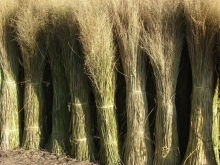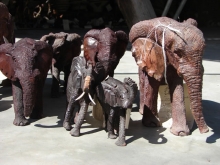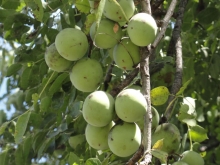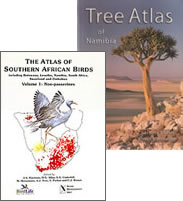Flora
Vegetation
The Mudumu Landscape is rich in plants that are valuable to both people and wildlife. Common and valuable species include the red syringa, Angolan teak, Zambezi teak, false mopane, silverleaf terminalia, bird plum, camel thorn, leadwood, devil’s claw and Kalahari melon. With around 125 species of trees, the Mudumu landscape supports a large diversity of tree and other plant species, largely due to its high rainfall and the diversity of habitats including riverine forest, floodplains and islands as well as dry, deciduous woodlands on deep sand. Many species in this area are at the edge of their distributions and are not found in the rest of Namibia.
Vegetation is influenced by the geology and drainage of the Kalahari Basin. Thus, while much of the area is covered in well-drained sands, areas along river courses have a higher clay content, are more fertile and hold more moisture, thus supporting different natural vegetation and also allowing different crops to be grown. Most trees cannot grow in water-logged soils which is why floodplains along the major rivers are generally dominated by grasslands.
There are four community forests, which aim to manage woody resources sustainably and to improve livelihoods. In addition to trees, a number of highly valuable non-timber forest products such as Devil’s Claw are abundant. Vast grasslands provide grazing and browsing areas for livestock and game.
Relevant literature
-
Assessment of Non-Wood forest products in eastern Caprivi. Community Forest in North-Eastern Namibia
Assessment of Non-Wood forest products in eastern Caprivi. Community Forest in North-Eastern Namibia. Ministry of Environment and Tourism, Directorate of Forestry
Assessment of Non-Wood forest products in eastern Caprivi» Download -
Caprivi State Forest - The Forest Resource
Caprivi State Forest - The Forest Resource (From Forest Inventory). Namibia-Finland Forestry Programme
» Download -
Flora, fauna and conservation of East Caprivi wetlands
Schlettwein, C.H.G., Simmons, R.E., Macdonals, A. and Grobler, H.J.W. 1991. Flora, fauna and conservation of East Caprivi wetlands. Madoqua, 17(2): 67-76
The largest natural permanent surface waters in Namibia occur in the wetlands of East Caprivi and are fed by two of Namibia's five perennial rivers.» Download -
Forest inventory report of Caprivi Region
Chakanga, M., Korhonen, K. and Selänniemi, T. 1998. Forest inventory report of Caprivi Region. Ministry of Environment and Tourism, Directorate of Forestry, Namibia-Finland Forestry Programme
» Download -
Government Gazette. Declaration of an area as a Community Forest: Kwandu Community Forest
Government Gazette. Declaration of an area as a Community Forest: Kwandu Community Forest
» Download -
Government Gazette. Declaration of an area as a Community Forest: Lubuta Community Forest
Government Gazette. Declaration of an area as a Community Forest: Lubuta Community Forest
» Download -
Government Gazette. Declaration of an area as a Community Forest: Masida Community Forest
Government Gazette. Declaration of an area as a Community Forest: Masida Community Forest
» Download -
Government Gazette. Declaration of an area as a Community Forest: Sachona
Government Gazette. Declaration of an area as a Community Forest: Cuma, Gcwatjinga, George Mukoya, Kahenge, Katope, Likwaterera, Marienfluss, Muduva Nyangana, Nyae Nyae, Okondjombo, Ohepi, Omufituwekuta, Orupembe, Oshaampula, Otjiu-West, Puros, Sachona, Sanitatas, Zilitene
» Download -
Living with wildlife – the story of Mudumu North Complex
Living with wildlife – the story of Mudumu North Complex. NACSO. 20 pp.
Profile booklet providing information on Mudumu North Complex with sections on resources and attractions, livelihoods and development, managing natural resources, Kwandu conservancy, Mashi conservancy, Mayuni conservancy, Sobbe conservancy, community forestry, the Kyaramacan association, the national parks, challenges, opportunities and the future.» Download -
Marketing study for non-timber forest products for the north eastern regions of Namibia (Eastern Caprivi and Eastern Kavango).
Cole, D. 2003. Marketing study for non-timber forest products for the north eastern regions of Namibia (Eastern Caprivi and Eastern Kavango). The Namibia-Finland Forestry Programme
» Download -
People, plants and landscapes: A review and recommendations for further integration of high value plant species (HVPS) into Community Ecosystem Management in Namibia
Cunningham, A.B. 2007. People, plants and landscapes: A review and recommendations for further integration of high value plant species (HVPS) into Community Ecosystem Management in Namibia.
This report, written for the Integrated Community Ecosystem Management (ICEMA)/French Fund for Global Environment (FFEM) project, reviews and makes recommendations for further integration of high value plant species (HVPS) into Community Ecosystem Management in Namibia. As the driest country in sub-equatorial Africa, with an economy based largely on its natural resource assets (farming, mining, fishing and tourism focused on wildlife), Namibia faces major challenges. With policy support, it can also grasp good opportunities related to high value plant species. A focus on high value plant species is timely.» Download -
Plant resources & monitoring. Follow up report and recommendations on further integration of high value plant species into Community Ecosystem Management in Namibia
Cunningham, AB. 2008. Plant resources & monitoring. Follow up report and recommendations on further integration of high value plant species into Community Ecosystem Management in Namibia. A report for the Integrated Community Ecosystem Management (ICEMA)/French Fund for Global Environment (FFEM) Project
» Download -
Woody Resources Report of Kwando Community Forest
Kamwi, J.M. 2003. Woody Resources Report of Kwando Community Forest. Ministry of Environment and Tourism, Directorate of Forestry. Namibia-Finland Forestry Programme
» Download







